Luận án Research on establishing the neural stimulation system and apply for evaluating the spatial response of hippocampal place neurons
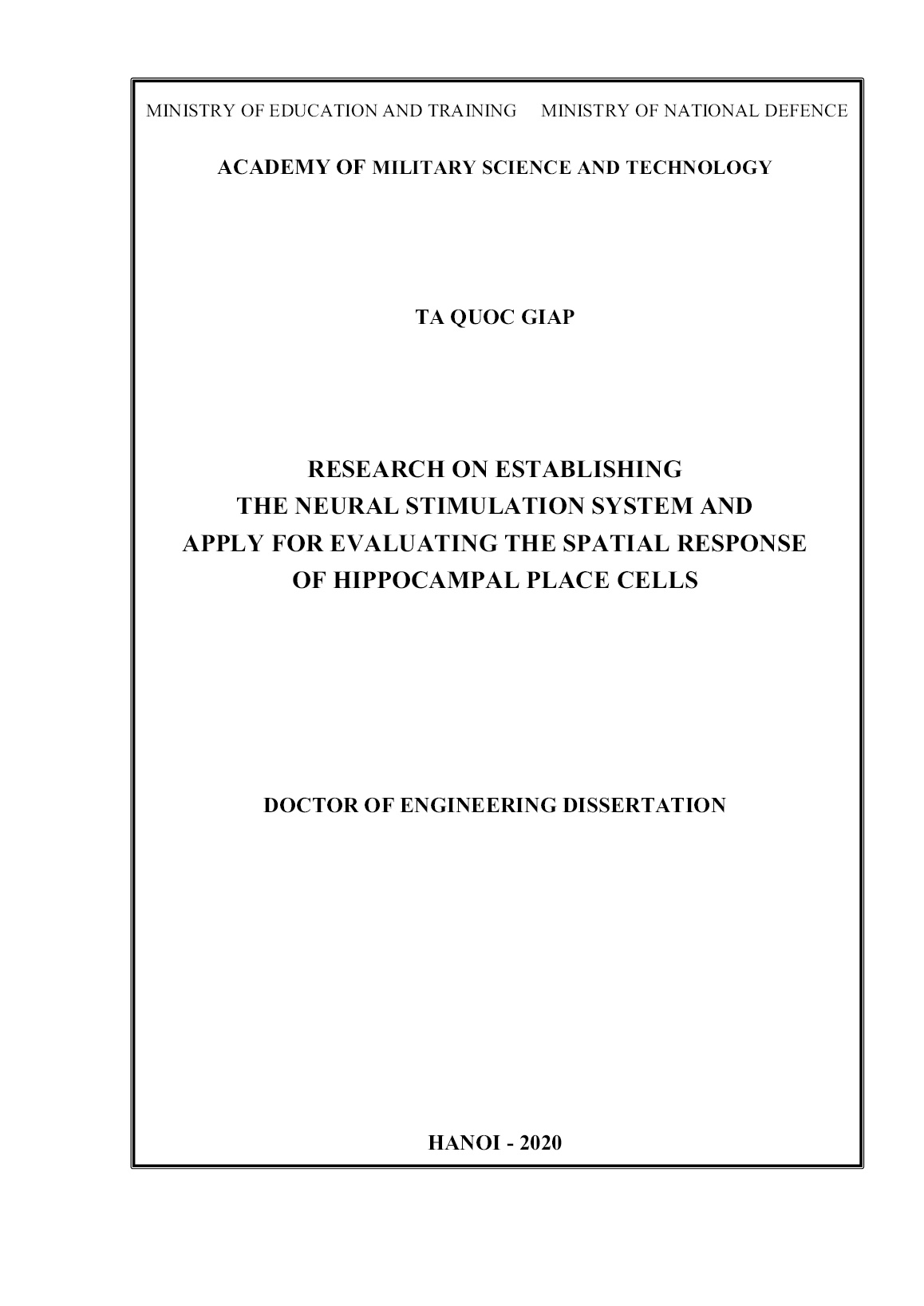
Trang 1
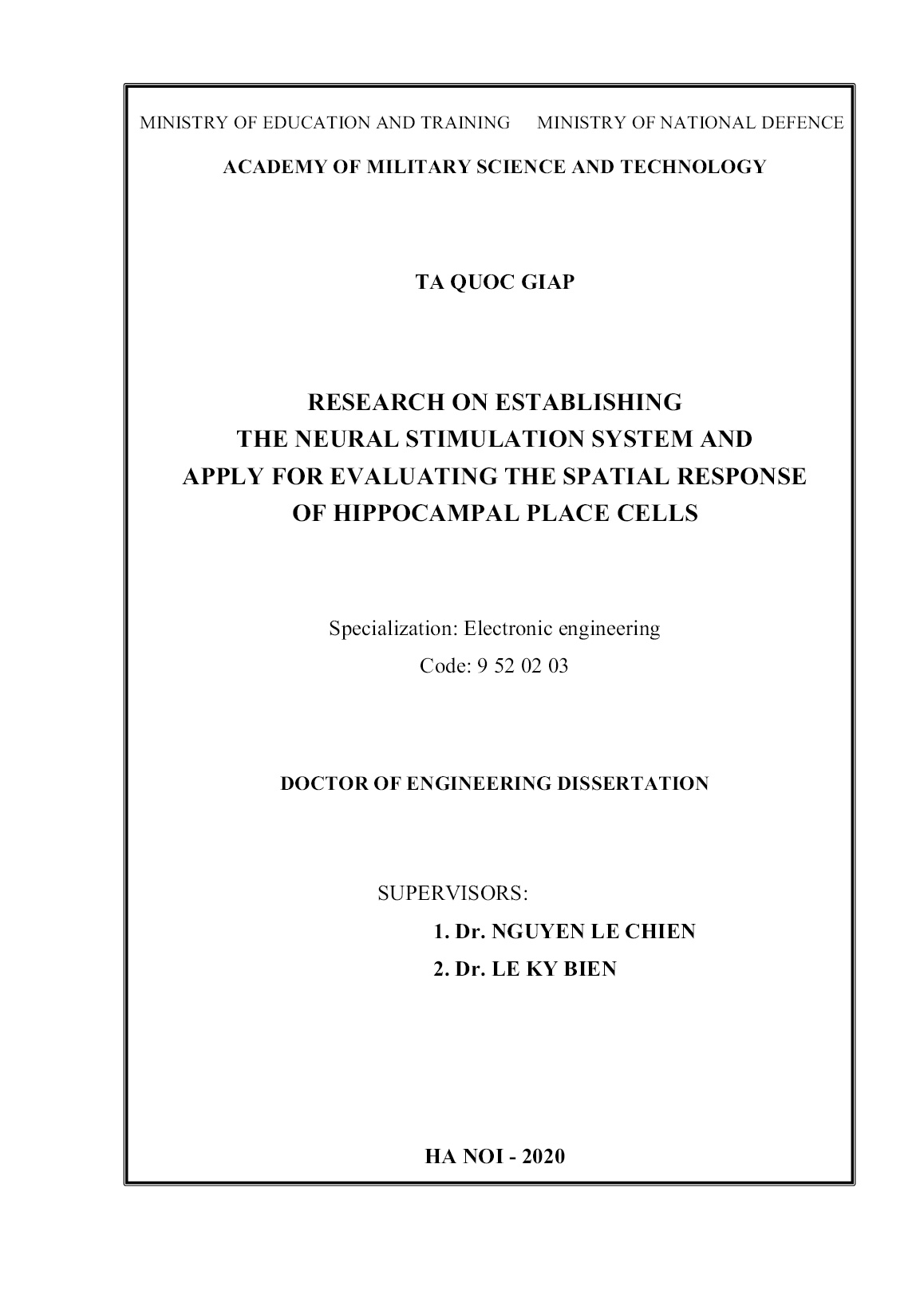
Trang 2

Trang 3

Trang 4
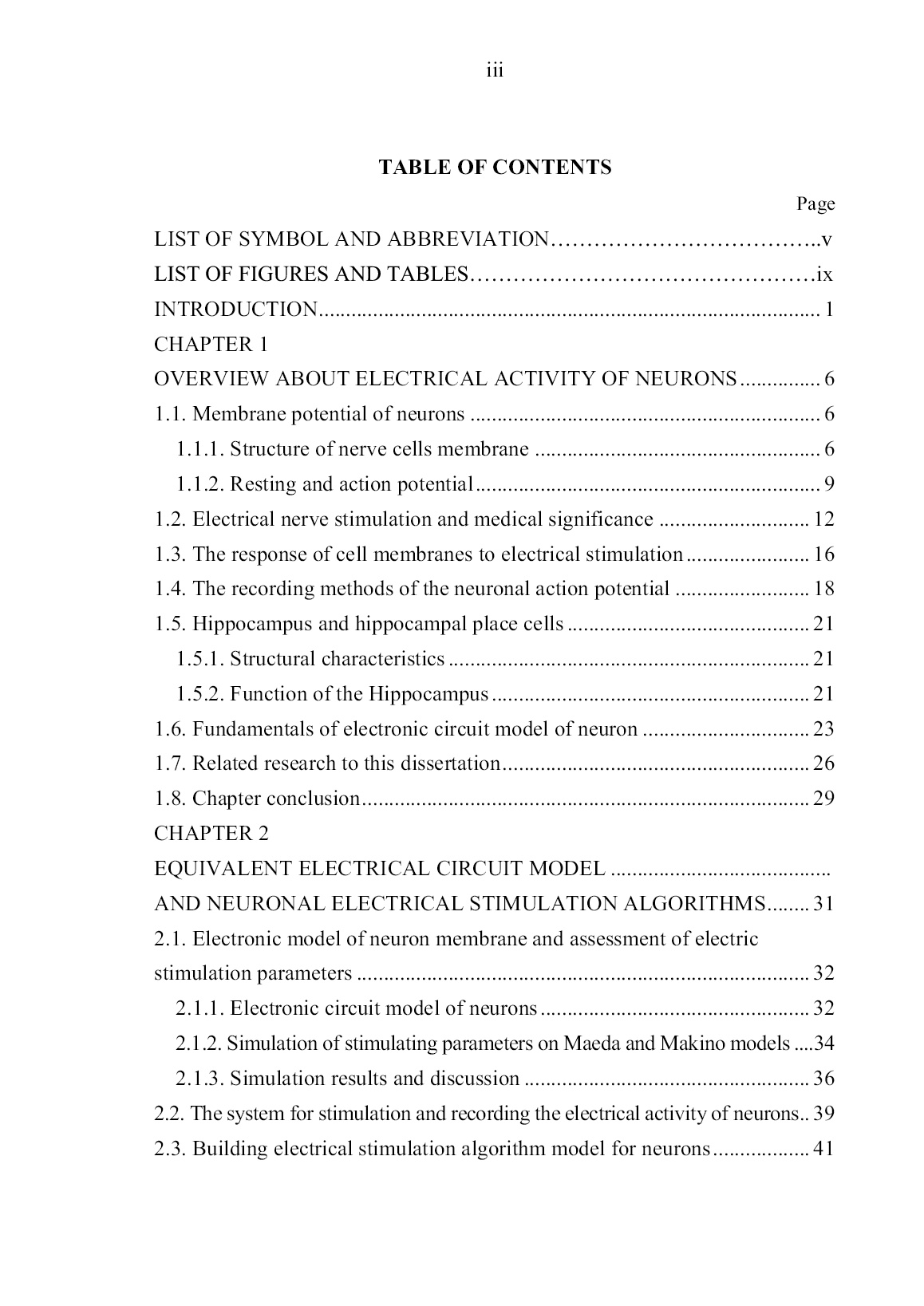
Trang 5
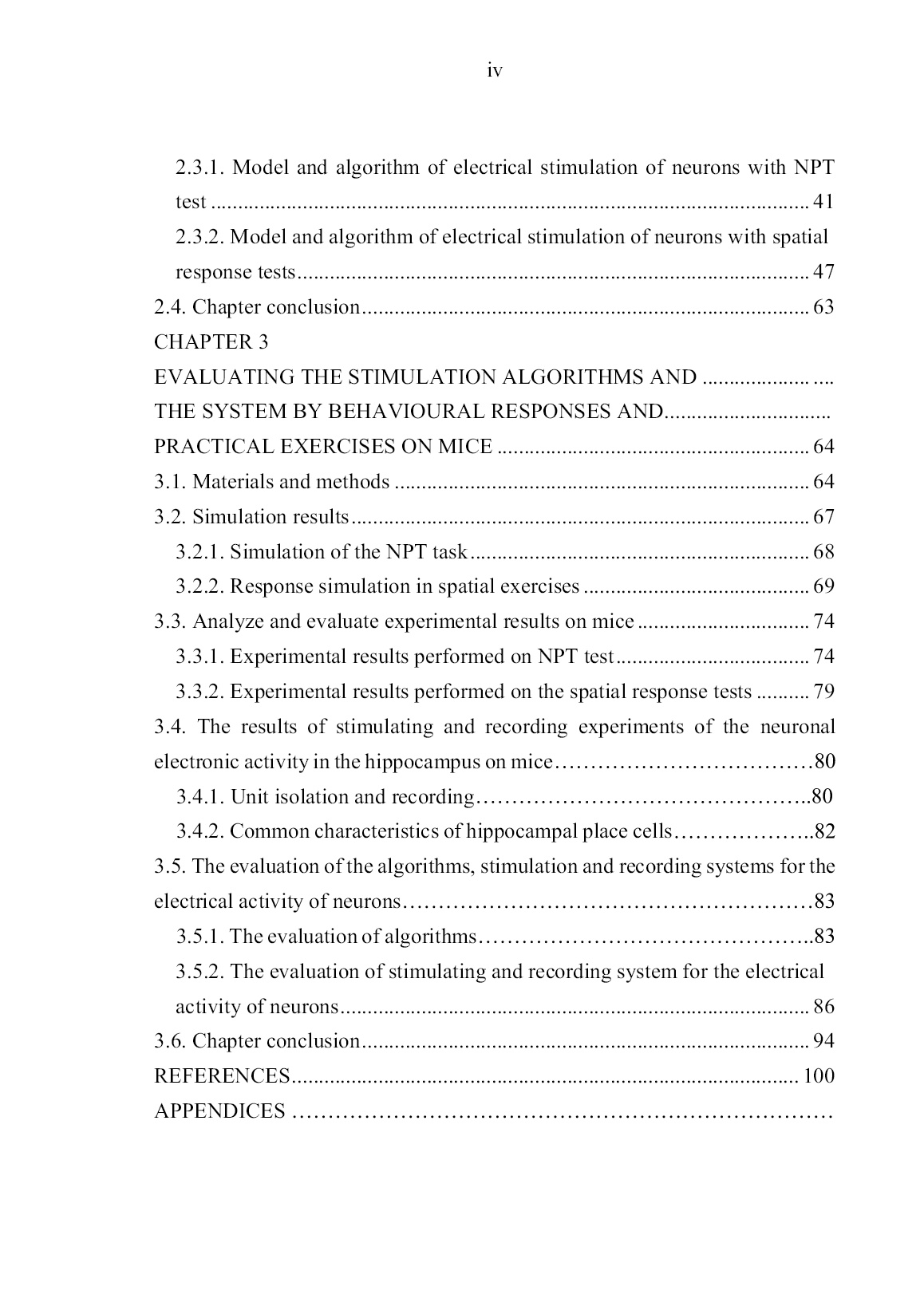
Trang 6
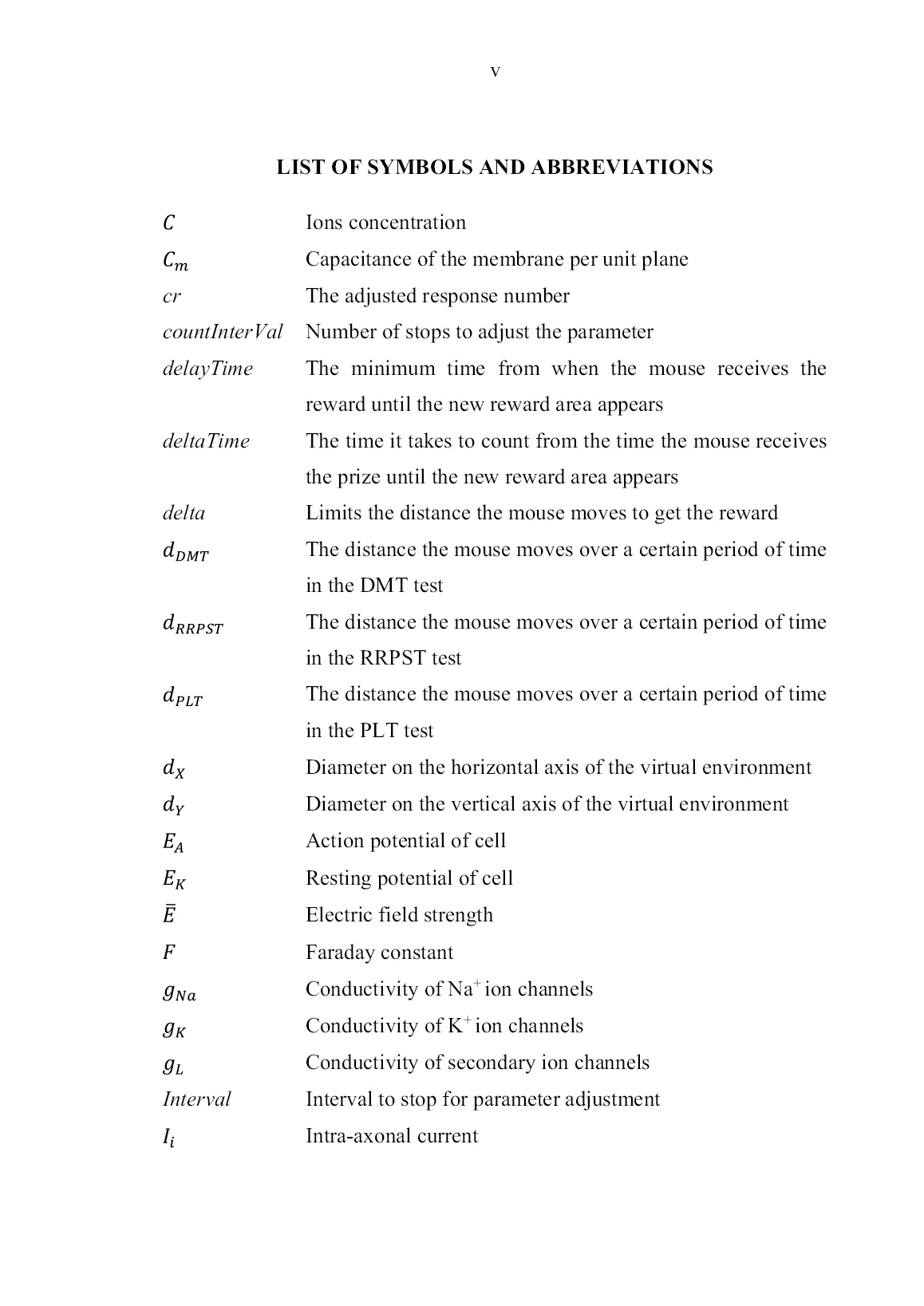
Trang 7
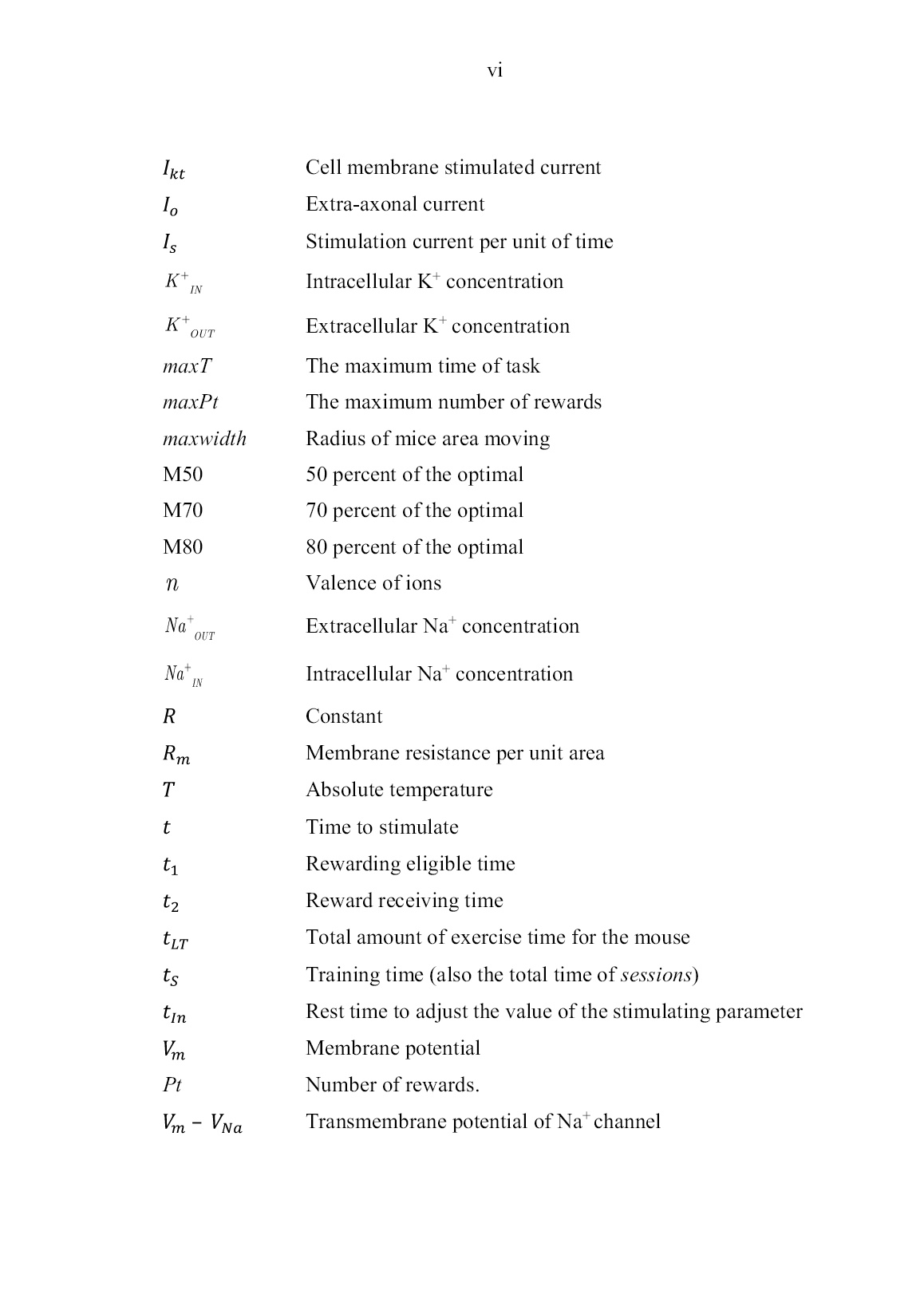
Trang 8
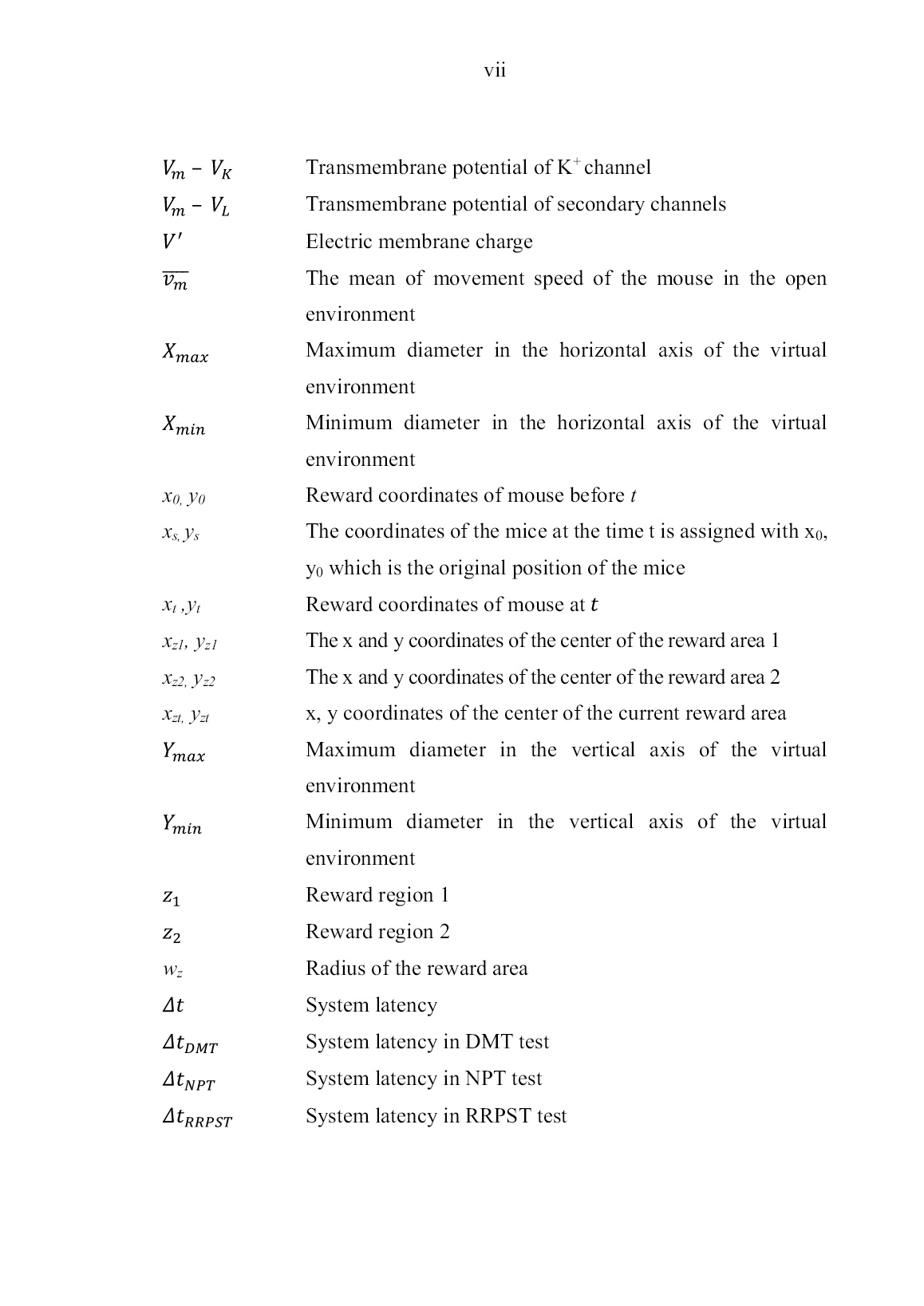
Trang 9
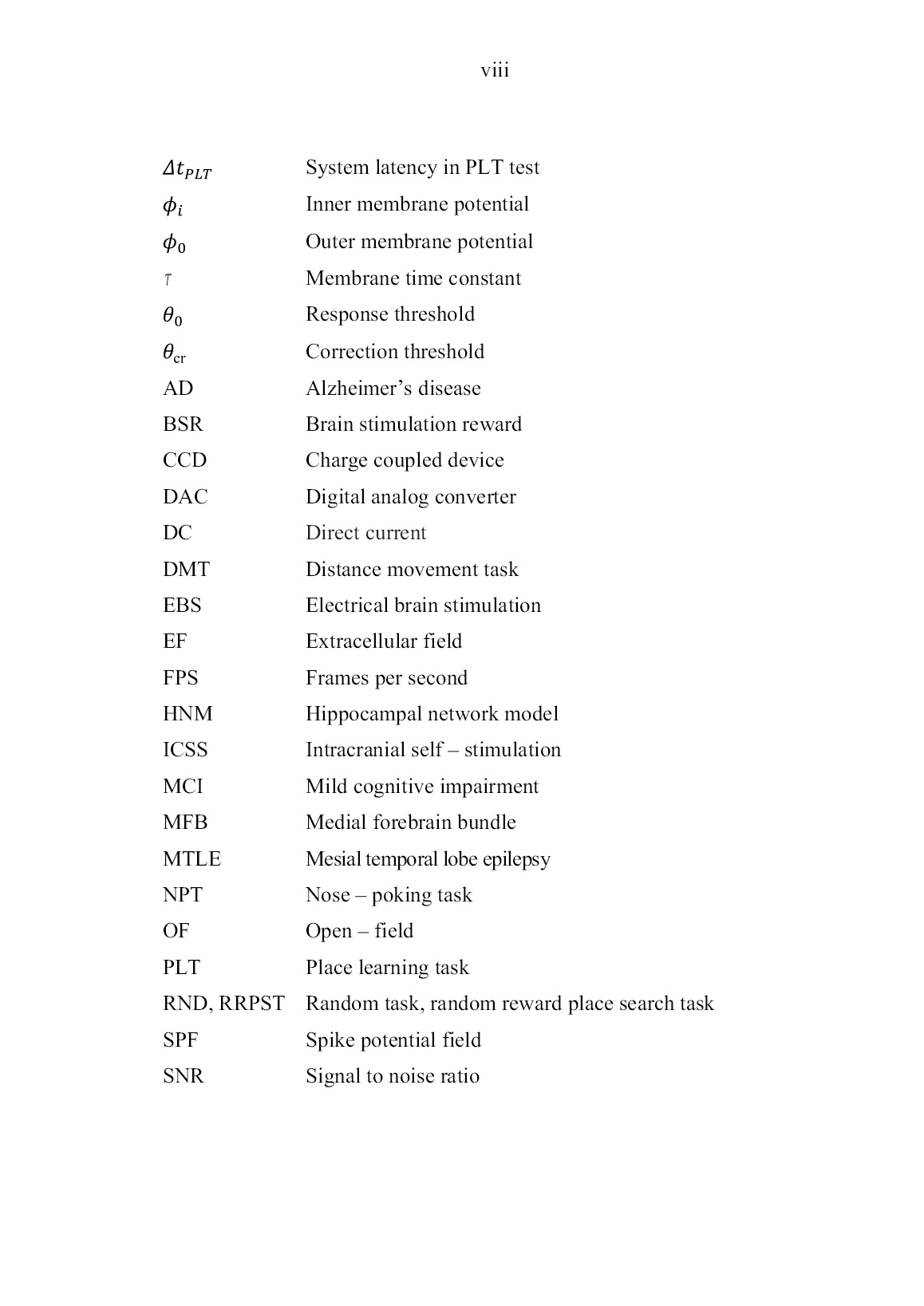
Trang 10
Tải về để xem bản đầy đủ
Bạn đang xem 10 trang mẫu của tài liệu "Luận án Research on establishing the neural stimulation system and apply for evaluating the spatial response of hippocampal place neurons", để tải tài liệu gốc về máy hãy click vào nút Download ở trên.
Tóm tắt nội dung tài liệu: Luận án Research on establishing the neural stimulation system and apply for evaluating the spatial response of hippocampal place neurons
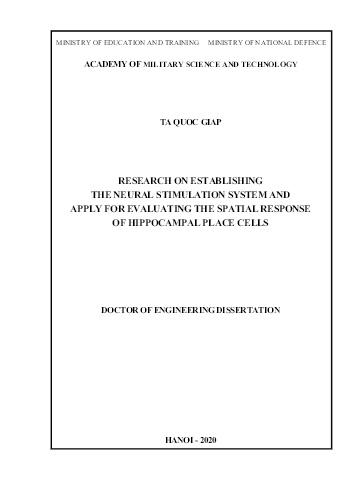
Start Chammui End Figure 2.11. Flow chart of the NPT test. in which: - Pt: number of rewards. - maxPt: the maximum number of rewards in a single episode (conditions to stop the program). - chammui: When the mice touches the nose with the sensor. 46 - t: timer variable. - maxT: maximum time for one exercise (condition to stop the program). - ptDelta: reward for the delta period. - tDelta: variable counting in delta time. - delta: the amount of time to count the reward. - countInterVal: number of stops to adjust the parameter. - Interval: interval to stop for parameter adjustment. The flowchart of the excitation algorithm for the NPT test is explained by the following steps: Step 1: Initialize values: - Pt: number of rewards assigned to 0. - chammui: the number of mouse touches the nose assigned to 0. - T: timer variable is assigned to 0. - tDelta: variable counting in delta time is assigned to 0. - delta: initialize the variable to count the number of rewards in a period of time. - countInterVal: number of stops to adjust the parameter is set to 0. - interval: interval to stop parameter adjustment. - maxPt: the maximum number of rewards once a set, is set in advance (conditions stop the program). - maxT: time limit once a set, set before (conditions stop the program). Step 2: - Increase timer variable. - The data reading unit reads the pulses sent from the sensor to meet the condition of the nose poke. Step 3: If mouse pokes nose, reward count is returned chammui = 0, reward is cumulative, the number of rewards in the delta time period is cumulative. Step 4: 47 - If the timer by tDelta is equal to the counting time, save the number of rewards received and reset the reward and time counter. - Also compare the time with the Interval time and count down the Interval time. Step 5: If pt = maxPt or t = maxT then the program is stopped, if else check the Interval, count down and repeat Step 2. 2.3.2. Model and algorithm of electrical stimulation of neurons with spatial response tests In order to assess the response of neurons to electrical impulse stimulation, it is necessary to develop related exercises to assess spatial response through animal behavior, the dissertation builds a stimulation algorithm through post spatial response exercises: distant movement task (DMT), random-reward place search task (RRPST) and Place learning task (PLT). Establish virtual open field: The mice performed the exercise in an open environment, a black painted cylindrical box with a diameter of 80cm, a height of 25cm, placed on a rotating cylinder 80cm high above the floor so that it could be rotated under experimental conditions. The mouse is mounted with an LED to track coordinates as well as running paths in an open environment (Open Field: OF). The virtual OF program has a specific diameter and center. Set the fixed leds to OF and rotate a closed circle. Two-dimensional coordinates (X, Y) on the position of the leds provided by Cineplex version 2.0 (Plexon Inc., USA) with a frequency of 30FPS. Determine the values 𝑋𝑚𝑖𝑛, 𝑋𝑚𝑎𝑥, 𝑌𝑚𝑖𝑛, 𝑌𝑚𝑎𝑥 as unit of pixel of led in virtual OF. - Determine diameter of virtual OF: Compare 𝑑𝑋 = 𝑋𝑚𝑎𝑥 − 𝑋𝑚𝑖𝑛 with 𝑑𝑌 = 𝑌𝑚𝑎𝑥 − 𝑌𝑚𝑖𝑛. The larger is the diameter of virtual OF. - Determine cm – pixel ratio: real OF diameter is 80cm, virtual OF diameter is as above. In this study, the cm-pixel ratio is 9,35. 48 Description: - Mice move in an open environment. - The coordinates of the mouse in an open environment are determined by the program in real time. Test stopping conditions Conditions to stop the exercise when either of the following conditions are met: - The number of rewards achieved is equal to the maximum number of rewards established (usually set by 50 rewards). - Training time is equal to the established time of the exercise (usually set to 600s). 2.3.2.1. Model of stimulating nerve cell with DMT test Figure 2.12. The model for the DMT task. In the model described in Figure 2.12, the mouse is placed in an open environment and the coordinates are monitored by the CCD camera system and the central processor by Cineplex software version 2.0. The distance of the mouse moving in an open environment has a diameter of 80cm and is simulated with the running path of the mouse in virtual OF with pixel value: 1cm = 9.35pixel. During the exercise, when the reward condition of the required problem is satisfied, the central microprocessor sends the control signal to the excitation system via the NI6051 USB peripheral device. 49 The control signal activates an electric stimulus with a set parameter from the Stimulator and is transferred to the Isolator device to the mouse nerve cell via a stimulating electrode. 2.3.2.2. Develop electric stimulation algorithm for DMT test a) Significance of DMT test: The DMT exercise algorithm is based on strict requirements about rewarding conditions. If the distance traveled by the mouse from the previous reward position of the mouse at the time 0t , to the present time t and DMTd ≥ delta, then the mouse will be awarded, in which: 𝑑𝐷𝑀𝑇 = √(𝑥𝑡 − 𝑥0)2 + (𝑦𝑡 − 𝑦0)2 𝑥𝑡, 𝑦𝑡: coordinates of mouse at 𝑡; 𝑥0, 𝑦0: reward coordinates of mouse before t. The algorithm of the DMT task (Distance Movement Task) is based on strict requirements of reward conditions. The movements of mice will be trained with easy to difficult requirements by the experimental tasks for asserting the optimal intensity and frequency parameters of the stimulating electrical pulses. Those parameters were already determined in the NPT task previously. The electric stimulation algorithm evaluating motor skills is the basis for building the program and interface of DMT exercises presented in the content of chapter 3. The DMT exercise program is shown visually on the program interface with the study subjects were mice. In addition to the program of closely monitoring the conditions of awarding and automatically awarding when the conditions of exercise are satisfied; The number of times the prize or the distance traveled by the mouse is visually simulated the mouse track and update the number of awards and the distance the mouse performed. The values are saved as a file and analyzed objectively to assess the mouse's ability to move 50 in a given space. The expectation of the exercise is that the mouse will travel the longest distance and the track will cover the open environment. b) DMT test: Description: In an open environment, the mouse will receive a stimulus reward after moving a certain deltax distance (distance can be set and adjusted on the software interface). This distance is set according to how easy or difficult it is and usually varies from 50 - 100cm. This set up motivates the animals to move in an open environment to gain more BSR over the training days. Attention: In case of loss of grip (suddenly losing the signal of the camera), the mouse position will return to the center of the open environment [coordinates (x; y) = (0; 0)]. There must be a condition algorithm to control this loss phenomenon to avoid large errors in the distance of travel, and the mouse is incorrectly rewarded. Rewarding conditions: The movement distance of the mouse is a certain delta. In this exercise, the requirements of the problem are increased, often placing the delta region in increments within a certain limit to ensure that the mouse is well trained. Test stopping conditions Conditions to stop the exercise when either of the following conditions are met: - The number of rewards achieved is equal to the maximum number of rewards established (usually set by 50 rewards). - Training time is equal to the established time of the exercise (usually set to 600s). c) Flowchart 51 Pt = 0; s = 0; t = 0; xt-1 = x0; yt-1 = y0; xt = x0; yt = y0; maxpt; maxT; delta t++; xt-1 = xt; yt-1 = yt s+ = sqrt[(yt-yt-1) 2 + (xt-xt-1) 2] s = 0 Pt++ Pt = maxPt || t = maxT yes yes no no s >= delta Reading data xt; yt Start End Figure 2.13. Stimulating algorithm flowchart for DMT test. Flowchart of DMT test is described in figure 2.13, in which: - Pt: number of rewards. - maxPt: the maximum number of rewards in a single episode (conditions to stop the program). - t: timer variable. 52 - maxT: maximum time for one exercise (condition to stop the program). - xt, yt: the x, y coordinates of the current position of the mouse, respectively - xs, ys: the x and y coordinates of the previous position of the mouse, respectively - delta: distance required to hover to get reward. The flowchart of stimulus algorithms for DMT test is explained by the following steps: Step 1: Initialize values - Pt: The number of rewards is assigned 0. - s: The travel distance of the mouse is assigned 0. - t: The timer variable is assigned by 0. - xt, yt: the coordinates of the mouse at the time t -1 is assigned with x0, y0 which is the original coordinates of the mouse. - xs, ys: the coordinates of the mice at the time t is assigned with x0, y0 which is the original position of the mice. - maxPt: the maximum number of rewards in a set, pre-set (conditions to stop the program). - maxT: time limit once a set, set before (conditions stop the program). - delta: limits the distance the mice moves to get the reward. Step 2: at each t , sx is assigned as ; t sx y is assigned as ty (of the past t). Data reading unit reads mouse’s location and assigned to xt, yt. Step 3: Accumulate the total moving distance of mouse using formula. Step 4: If the mice's travel distance is greater than the delta (limit the distance to receive the reward), the number of rewards is increased by 1 unit and the travel distance is set to 0, then go to step 5. If not repeat from step 2 (repeat the assignment of coordinates and reading data). 53 Step 5: If pt = maxPt or t = maxT then stop the program, if else repeat from step 2. 2.3.2.3. Stimulation model for RRPST and PLT tests The model of neuron stimulation for RRPST and PLT spatial response evaluation tests is depicted in Figure 2.14 as follows: Isolator Stimulator USB 6501 Plexon Central processing system AMP C C D cam era Monitor S tim ulating electrode recording electrode Mice Figure 2.14. The system for stimulation and recording the action potential of neurons on mice. In order to assess the response of neurons to electrical impulsive stimulation, related exercises should be developed to assess spatial response through animal behavior. The dissertation has built a stimulation algorithm, recorded the electrical activity of nerve cells through exercises to find random reward place search task (RRPST also known as RND) and place learning task (PLT) tests. From the models and algorithms for stimulating nerve cells that have been developed in the DMT exercises, this is an important step to build the model of the stimulating system and record the electric activity of nerve cells in the PLT and RRPST test with the incentive mechanism to determine eligibility for reward and distribute the rewards that has been established and recorded completely automatically (Figure 2.14). 54 The mouse performs the test in an open environment that is monitored by the camera system and sent to the central system. The electrical activity of the cell is recorded through an electrode that is amplified 1000 times through two amplification floors and processed by the Plexon system. During the exercise, when the prize conditions are met, the central processor will emit a control signal via the NI6501 USB peripheral to the device set by the Stimulator, via an isolator and digital converter - similar to the Isolator to the electrode that enters the mouse nerve cell. The electrical activity of nerve cells is recorded via an electrode system, the signal is amplified, filtered and displayed in the Plexon system. The coordinates of the mouse, the time of awarding the "reward" when the mouse satisfies the condition of receiving the "reward" and the time when the action potential of the nerve cell is synchronized, stored in file format and analyzed in specialized software to evaluate the ability to remember, seek rewards and spatial response of the mouse. Electrical stimulation with RRPST test a) Significance of RRPST test The RRPST exercise algorithm is based on strict requirements about the conditions for rewarding when 𝑑𝑅𝑅𝑃𝑆𝑇 ≤ 𝑤𝑧 in which: 𝑤𝑧 (radius of the reward area) and 𝑑𝑅𝑅𝑃𝑆𝑇 (distance from the center of the reward area to the position of the mouse) is calculated by: 𝑑𝑅𝑅𝑃𝑆𝑇 = √(𝑥𝑡 − x𝑧)2 + (𝑦𝑡 − y𝑧)2 In which: (𝑥𝑧, 𝑦𝑧), (𝑥𝑡 , 𝑦𝑡): the coordinates of the center of the reward area and the coordinates of the mouse at t, respectively. The electric stimulation algorithm that evaluates motor skills and the need to find a reward is the basis for building the program and interface of the RRPST test presented in the content of the next chapter. Through this experimental exercise, we will train the mouse to search for rewards with the randomly generated reward area. RRPST test program is shown visually on the 55 program interface, the study subject is the mouse. In addition, the program closely monitors the conditions of rewarding and automatically rewards when the conditions of the test are satisfied; the number of rewarding or the distance traveled by the mouse is visually displayed by the mouse track and updated the number of rewards and the distance the mouse travelled. Those values are saved as a file and analyzed objectively to assess the mouse's motility for finding rewards in a given space. The expectation of an test is that the mouse receives the maximum number of rewards, moving the longest distance in a given time period of the test. b) RRPST test Description: For this exercise, the central processing program will define a circular reward area, with a delta diameter (pre-set and possibly changing the radius of a circle) with the center randomly defined and lying. in the circumscribed circle the open environment circle. The program will issue a control signal that activates an electrical pulse as soon as the animal's coordinates touch this reward area (for a condition of Reward delay = 0s). After the reward has been issued (or after the maximum duration of 30s of the reward area) this reward area disappears and a new reward area will appear and activate after a certain time (usually set 5s). Attention: The mouse only receives the reward when the coordinates of the animal intersect the reward area. The maximum duration of the reward area is 30 seconds, after 30 seconds, if the mouse does not reach the reward, the reward area will disappear and the new reward area will be activated after the next 5s. If during the 30s existence of the reward area the animal gains the reward, the reward area will be inactivated and a new reward area will be randomly activated after the interval of 5s. 56 Rewarding conditions - The mouse moves to the reward area and the next prize area only appears and is activated in a certain period of time. - The mouse in the reward area z a certain amount of time (reward delay) if the program set (the time is adjustable), the time of reward delay is defined as the time period since the mouse touches the area of reward until the mouse receives the reward and the mouse's position remains in the reward area. Test stopping conditions Conditions to stop the exercise when either of the following conditions are met: - The number of rewards achieved is equal to the maximum number of rewards established (usually set by 50 rewards). - Training time is equal to the established time of the exercise (usually set to 600s). c) Algorithm flowchart Algorithm of the RRPST test is described in Figure 2.15, in which: - Pt: number of rewards. - maxPt: the maximum number of rewards once a set, is set in advance (conditions stop the program). - maxT: the maximum time once a set, is set before (condition to stop the program). - t: timer variable. - xt, yt: x, y coordinates of the current position of the mouse. - xzt, yzt: x, y coordinates of the center of the current reward area. - wz: radius of the reward area. - maxwidth: radius of mouse area moving. - deltaTime: The time it takes to count from the time the mouse receives the prize until the new reward area appears. - delayTime: the minimum time from when the mouse receives the reward until the new reward area appears. 57 - vungnhanthuong: equal to true if the mouse has just received a reward and the new reward area has not yet appeared, with false if the mouse has not received a reward when the new reward area appears. Pt = 0; t= 0; xt = x0; yt = y0; xzt = xz0; yzt = yz0; wz deltaTime = 0; delayTime; maxwidth; maxPt; maxT; taovungpt = false t++; deltaTime++; delta = sqrt[(xt – xzt) 2 + (yt – yzt) 2 ] delta = 0 taovungpt = true Pt++; deltaTime =0 delta <= wz & taovungpt = false yes yes no deltaTime>= delayTime & taovungpt = true xzt = rand(0,maxwidth) yzt = rand(0,maxwidth) Pt == maxPt || t == maxT no no yes Reading data xt; yt End Start Figure 2.15. Algorithm flowchart for the RRPST test. 58 The flowchart of the stimulus algorithm for RRPST exercises is explained as follows: Step 1: Initialize values - Pt: The number of rewards is assigned 0. - t: The timer variable is assigned by 0. - xt, yt: the coordinates of the mouse at the time t -1 is assigned with x0, y0 which is the original coordinates of the mouse. - xz1, yz1: coordinates of center of rewarding zone. - maxPt: the maximum number of rewards in a set, pre-set (conditions to stop the program). - maxT: time limit once a set, set before (conditions stop the program). - delta: limits the distance the mouse moves to get the reward. - wz: radius of the reward area. Step 2: At each t, data reading block reads the mouse's new position on the variable xt, yt. Increase deltaTime. Step 3: If deltaTime is greater than or equal to the delay time and the distance from the mouse to the center of the prize area is equal to or smaller than the radius of the reward area, the mouse is rewarded. If these conditions are not met, calculate the distance traveled by the mouse and move to step 4. Step 4: If mouse is in rewarding zone and nhanthuong = false then proceed to step 5. If else repeat step 2. Step 5: Assign delta = 0, nhanthuong = true, increase rewards and assign deltaTime = 0. 59 Step 6: If pt = maxPt or t = maxT then stop the program, if else repeat from step 2. Electrical stimulation with PLT a) Significance of PLT test The PLT exercise algorithm relies on strict requirements about the conditions for awarding when 𝑑𝑃𝐿𝑇 ≤ 𝑤𝑧 in which: 𝑤𝑧 (radius of active reward zone) và 𝑑𝑃𝐿𝑇 (distance from center of reward area to mouse position) is calculated similar to the RRPST test: in which: - 𝑥𝑧, 𝑦𝑧: x, y coordinates of center of rewarding zone. - 𝑥𝑡, 𝑦𝑡: x, y coordinates of mouse at t, respectively. The electric stimulation algorithm that evaluates motor skills and the need to find a reward is the basis for building the program and interface of the PLT test presented in the content of the next chapter. Through this experimental exercise, we will train the mouse to search for rewards with the randomly generated reward area. PLT t
File đính kèm:
 luan_an_research_on_establishing_the_neural_stimulation_syst.pdf
luan_an_research_on_establishing_the_neural_stimulation_syst.pdf ThongTin KetLuanMoi LuanAn NCS TaQuocGiap.doc.doc
ThongTin KetLuanMoi LuanAn NCS TaQuocGiap.doc.doc TomTat LuanAn NCS TaQuocGiap_English.pdf
TomTat LuanAn NCS TaQuocGiap_English.pdf TomTat LuanAn NCS TaQuocGiap_TiengViet.pdf
TomTat LuanAn NCS TaQuocGiap_TiengViet.pdf TrichYeu LuanAn NCS TaQuocGiap.doc.doc
TrichYeu LuanAn NCS TaQuocGiap.doc.doc

